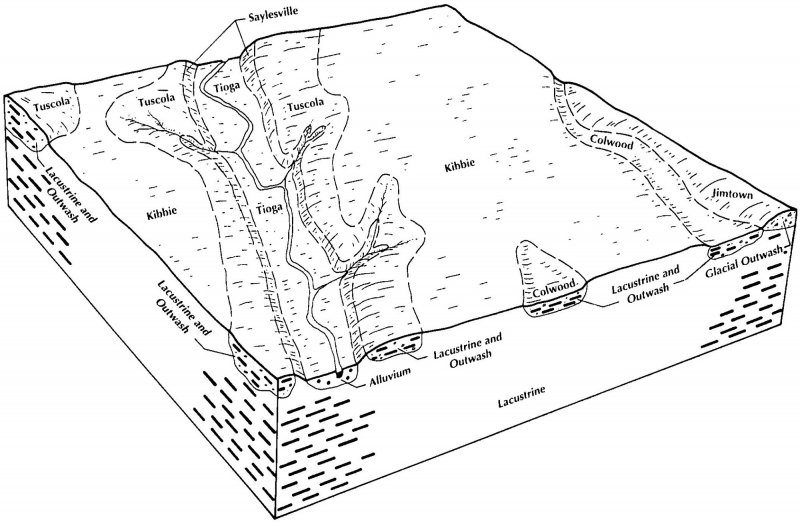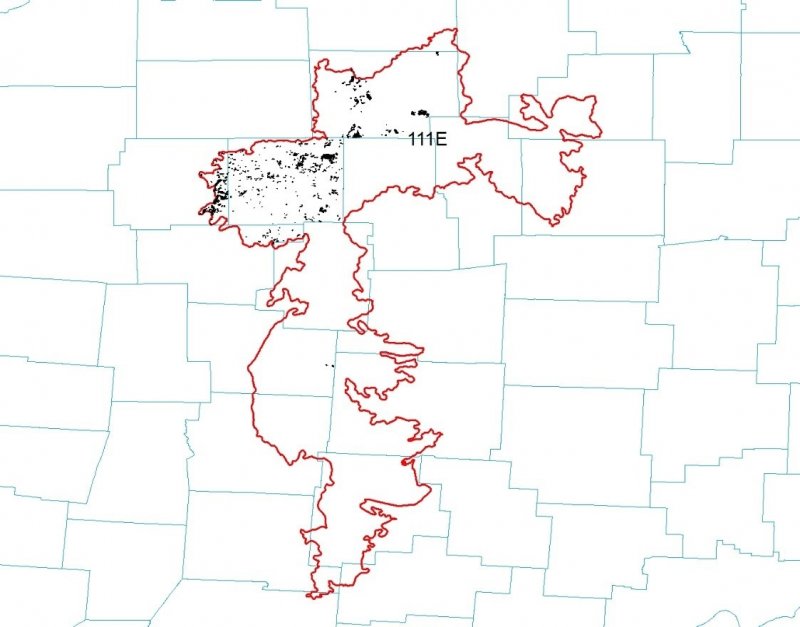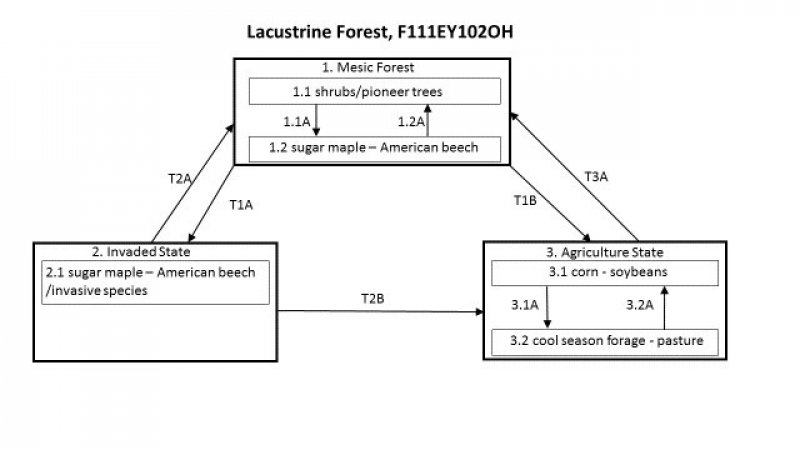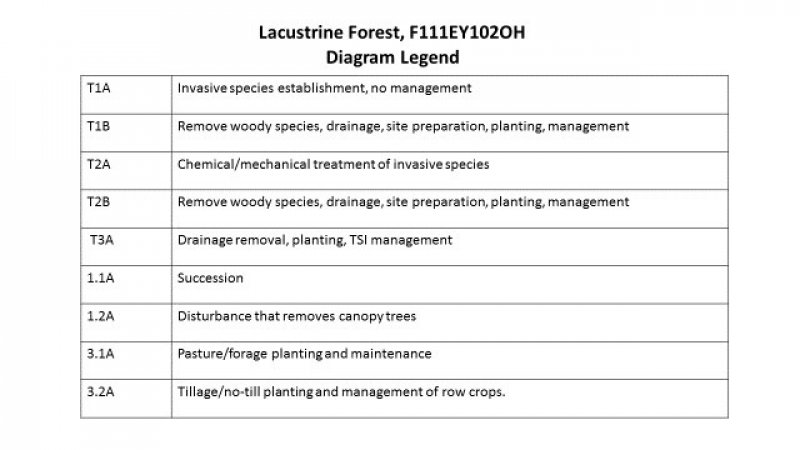
Natural Resources
Conservation Service
Ecological site F111XE102OH
Lacustrine Forest
Last updated: 9/11/2024
Accessed: 12/21/2025
General information
Provisional. A provisional ecological site description has undergone quality control and quality assurance review. It contains a working state and transition model and enough information to identify the ecological site.
MLRA notes
Major Land Resource Area (MLRA): 111X–Indiana and Ohio Till Plain
111E – Indiana and Ohio Till Plain, Eastern Part. Most of this area is in the Till Plains Section of the Central Lowlands Province of the Interior Plains. The northeast tip of the area is in the Southern New York Section of the Appalachian Highlands. The entire area has been glaciated. It is dominated by ground moraines that are broken in places by kames, lake plains, outwash plains, terraces, and stream valleys. Narrow, shallow valleys commonly are along the few large streams in the area. Elevation ranges from 580 to 1,400 feet (175 to 425 meters), increasing gradually from west to east. Relief is mainly a few meters, but in some areas hills rise as much as 100 feet (30 meters) above the adjoining plain.
The extent of the major Hydrologic Unit Areas (identified by four-digit numbers) that make up this MLRA is as follows: Scioto (0506), 33 percent; Muskingum (0504), 31 percent; and Western Lake Erie (0410), 28 percent; Upper Ohio (0503), 5 percent; and Southern Lake Erie (0411), 3 percent. The headwaters of many rivers in central Ohio, including the Vermillion, Black Fork, Sandusky, Little Scioto, and Olentangy Rivers, are in this MLRA.
This MLRA is underlain by late Devonian shale and sandstone. Surficial materials include glacial deposits of till, glaciolacustrine sediments, and outwash from Wisconsin and older glacial periods.
Classification relationships
Major Land Resource Area (USDA-Natural Resources Conservation Service, 2006)
USFS Ecological Regions (USDA, 2007):
Sections –Central Till Plains, Beech Maple (222H), Western Glaciated Allegheny Plateau (221F)
Subsections – Allegheny Plateau (221Fa), Bluffton Till Plains (222Ha), Miami-Scioto Plain – Tipton Till Plain (222Hb)
NatureServe Systems anticipated (NatureServe, 2011): Agriculture - Cultivated Crops and Irrigated Agriculture, Agriculture – Pasture/Hay, North-Central Interior Beech-Maple Forest, North-Central Interior Dry-Mesic Oak Forest and Woodland, Ruderal Forest, Ruderal Upland - Old Field
LANDFIRE Biophysical Settings anticipated (USGS, 2010): North-Central Interior Beech-Maple Forest, North-Central Interior Dry-Mesic Oak Forest and Woodland
Ecological site concept
This site is an upland site formed on lacustrine parent materials in soils that are somewhat poorly to moderately well drained. These soils generally occur on lake plains, moraines, or terraces often with some slope or on a convex surface. The site is located on generally flat topography, but slopes can reach to 18% at the margins of the landform features.
The characteristic vegetation of the site is a mesic forest with the understory and canopy dominated by fire sensitive, shade tolerant species most notably sugar maple and American beech, with tulip tree and basswood also being common. Canopy level associates include white oak, hackberry, and black walnut. Catastrophic windthrow was the most common, large scale disturbance event on this site and even those only occurred about every 300-500 years. Small gap disturbance caused by local windthrow or mortality was the main disturbance event that allowed the site to become dominated by fire sensitive, shade tolerant species. The largest risk to extant natural representation of the site is by invasion of non-native plants that, if unchecked, can dominate the understory. This greatly changes the species richness and diversity of the understory as the non-native plants, particularly species of Asian bush honeysuckle, exclude most all other species. The dominant canopy level trees are not threatened by these species, however given enough time this change could alter the composition of the canopy by altering the species that can get established in the understory. A large portion of this site has been drained and is in agricultural production. The majority of the converted acres is used for small grain rotations, specifically corn and soybeans. A much smaller amount of the site is also used for growing forage that is used for pasture or hay production. These sites are predominately cool season grass species and legumes such as tall fescue and clover species. The largest risk to extant natural representation of the site is by invasion of non-native plants that, if unchecked, can dominate the understory.
Associated sites
| F111XE101OH |
Lacustrine Flatwood Lacustrine Flatwood. Soils very poorly or poorly drained |
|---|---|
| F111XE501OH |
Till Depression Till Depression. Located on glacial till parent materials; generally lower on the landscape; frequently ponded. |
Similar sites
| F111XE301OH |
Wet Restricted Wet Restricted. Located on residuum parent materials; soils are somewhat poorly drained. |
|---|---|
| F111XE502OH |
Wet Till Ridge Wet Till Ridge. Located on glacial till parent materials; site located on a convex landscape position; soils are somewhat poorly drained. |
| F111XE403OH |
Outwash Upland Outwash Upland. Located on outwash parent materials; soils are very poorly to somewhat poorly drained; site often located higher on the landscape. |
| F111XE503OH |
Till Ridge Till Ridge. Located on glacial till parent materials; site located on a convex landscape position; soils are moderately well to well drained. |
| F111XE204OH |
Dry Alluvium Forest Dry Alluvium Forest. Located on alluvium parent materials; soils are moderately well to well drained. |
Table 1. Dominant plant species
| Tree |
(1) Acer saccharum |
|---|---|
| Shrub |
Not specified |
| Herbaceous |
Not specified |
Click on box and path labels to scroll to the respective text.



